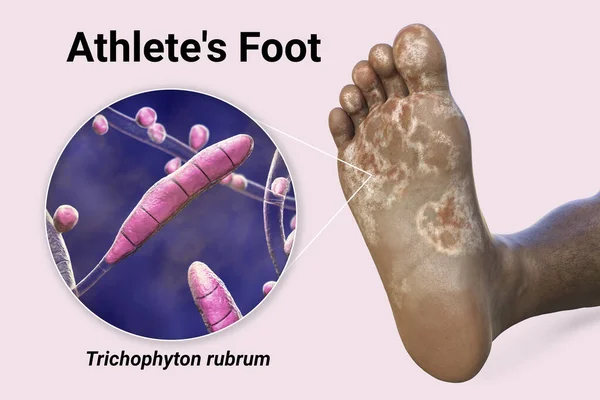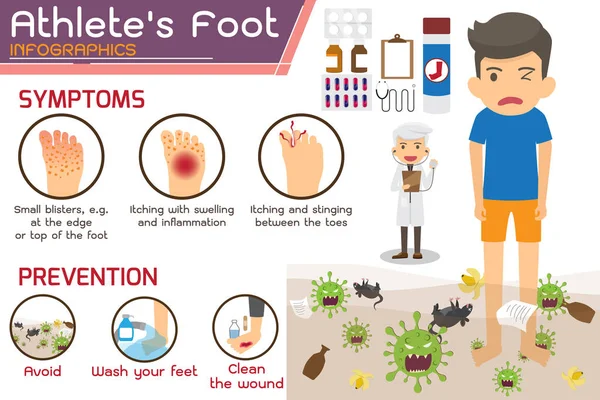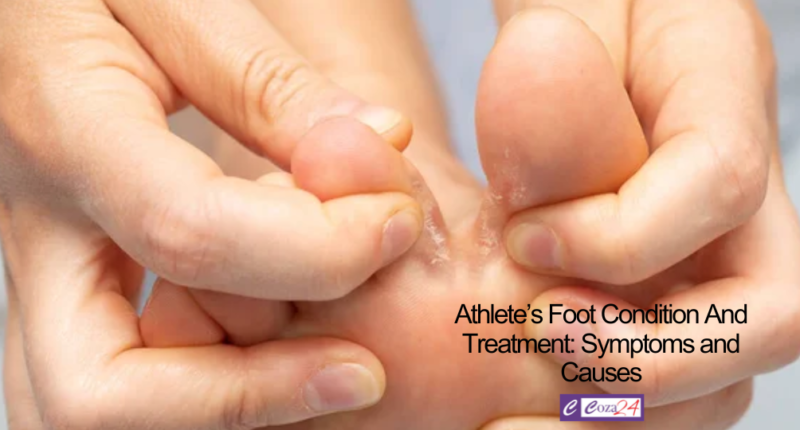Get to know “Athlete’s Foot Condition And Treatment” A Nuisance that Requires Attention. When it comes to Athlete’s Foot, it’s more than just an inconvenience. This common fungal infection can cause discomfort and affect your daily life.
When the topic of fungal infections arises, one often thinks of mushrooms sprouting in damp, dark corners. However, not all fungi manifest so visibly. Athlete’s Foot, also known as tinea pedis, is a prime example of a fungal infection that often conceals its presence until the symptoms become unmistakable. In this article, we’ll delve into the symptoms and causes of Athlete’s Foot and explore effective treatment options.

Table of Contents
The Stealthy Culprit: Trichophyton Fungi
At the heart of Athlete’s Foot lies the cunning Trichophyton fungus. This microbial miscreant is responsible for a significant number of fungal infections on the skin, particularly the feet. It thrives in warm, moist environments, which makes your feet an ideal breeding ground.
Understanding the Symptoms
- Itchy Irritation: One of the first signs of Athlete’s Foot is an incessant itching sensation. The affected area, usually between the toes, becomes red and itchy. This discomfort can sometimes be mistaken for a simple irritation.
- Burning Sensation: As the infection progresses, you may experience a burning sensation. This can be quite uncomfortable and make wearing shoes or even walking a painful ordeal.
- Cracked Skin: Athlete’s Foot can cause the skin to crack, especially in the areas between your toes. This not only exacerbates the discomfort but also increases the risk of secondary infections.
- Peeling Skin: The skin may begin to peel, giving it a scaly appearance. This is a classic sign of a fungal infection.
- Blisters: In some cases, blisters may develop. These blisters can be filled with fluid and cause additional discomfort.
- Odor: Athlete’s Foot can lead to an unpleasant odor. The combination of moisture and fungi is often the cause.
Delving into the Causes
Now that we’ve explored the symptoms, let’s understand the causes of Athlete’s Foot.
- Fungal Culprit: Athlete’s Foot is primarily caused by a group of fungi known as dermatophytes. These fungi thrive in warm and damp environments, such as the inside of your shoes.
- Contagious Nature: Athlete’s Foot is highly contagious. You can contract it by coming into contact with contaminated surfaces, like gym floors or shared shower areas. Moreover, close personal contact with an infected individual can also lead to transmission.
- Poor Foot Hygiene: Neglecting proper foot hygiene can make you more susceptible to this condition. Not drying your feet thoroughly after bathing or failing to change your socks regularly can increase the risk.
- Tight Footwear: Wearing tight, non-breathable shoes can create the perfect environment for the fungi to thrive. The lack of ventilation and moisture buildup can contribute to Athlete’s Foot.
- Weakened Immune System: Individuals with weakened immune systems are at a higher risk. Conditions such as diabetes or HIV can compromise your body’s ability to fight off fungal infections.
Effective Treatment Options
When faced with Athlete’s Foot, it’s crucial to seek prompt treatment. Here are some effective options:

1. Over-the-Counter (OTC) Topical Medications
For mild cases of Athlete’s Foot, over-the-counter antifungal creams, ointments, or sprays can be the initial line of defense. These medications typically contain active ingredients such as clotrimazole, miconazole, or terbinafine. It is imperative to follow the instructions on the product label and continue the treatment for the recommended duration, even if symptoms improve.
2. Prescription Medications
In cases where the infection is more severe or not responding to OTC treatments, a healthcare provider may prescribe stronger antifungal medications. These may be in the form of topical creams or oral medications. The duration of treatment will vary depending on the prescription and the individual’s response.
3. Lifestyle Changes
Complementary to medication, certain lifestyle adjustments can speed up the healing process and prevent recurrent infections.
- Foot Hygiene: Maintaining proper foot hygiene is paramount. Keep your feet clean, dry, and well-ventilated. Use moisture-wicking socks and change them regularly.
- Footwear: Choose footwear that allows your feet to breathe. Opt for shoes made from natural materials like leather or canvas, which promote airflow.
- Avoiding Contaminated Areas: Be cautious in communal areas with increased risk of fungal transmission. Use flip-flops in locker rooms and avoid sharing personal items like towels.
- Drying Between Toes: After bathing, ensure that the spaces between your toes are completely dry. Moisture trapped in these areas can be an inviting environment for fungal growth.
4. Natural Remedies
Some individuals explore natural remedies such as tea tree oil, vinegar soaks, or garlic to combat Athlete’s Foot. While these can be beneficial for mild cases, they are not a substitute for medically proven treatments. Consult with a healthcare provider before relying solely on natural remedies.
5. Prevention Measures
Prevention is, without a doubt, the best approach when it comes to Athlete’s Foot. These strategies can help reduce your risk:
- Proper Foot Hygiene: Regularly wash your feet and keep them dry, especially between the toes.
- Choose Appropriate Footwear: Opt for shoes that are well-ventilated and made from breathable materials.
- Foot Protection: When using public facilities like swimming pools or gyms, wear flip-flops or sandals to minimize direct contact with contaminated surfaces.
- Avoid Sharing Personal Items: Towels, socks, and shoes should not be shared, as they can harbor the fungus.
- Regular Foot Inspections: Keep an eye on your feet for any signs of infection, and seek treatment promptly if you suspect Athlete’s Foot.
The Verdict: Be Vigilant and Seek Treatment
Athlete’s Foot is a common condition that can disrupt your daily life and cause discomfort. However, it is not insurmountable. With timely treatment and preventive measures, you can effectively manage and eventually eliminate the infection. It is crucial to remember that persistent or recurrent cases may require professional medical attention. If you suspect you have Athlete’s Foot, do not hesitate to consult a healthcare provider for the most appropriate course of action.
Bottom Line
In conclusion, understanding the symptoms, causes, and treatment options for Athlete’s Foot is the first step in safeguarding yourself against this stealthy fungal intruder. By following proper foot hygiene practices and making informed choices, you can keep your feet healthy, itch-free, and free from the clutches of Trichophyton fungi.









